(Posted 26 February 2013) With the next solar eclipse visible from Australia only a few months away, now is the time to consider how you are going to observe it safely. Unlike last November’s Total Solar Eclipse, the eclipse on the morning of Friday 10 May 2013 will either be partial or annular depending on where you are in Australia. This is important to consider in your planning from a safety viewpoint, as it means that during the eclipse, there will always be part of the Sun visible. This rules out looking at the Sun with the unprotected eye for even a brief period of time – due to the vast amount of ultraviolet radiation that the Sun gives off. Essentially looking at the Sun without the use of specialist filters equals permanent blindness or at very best the development of cataracts then blindness. Neither option is desirable.
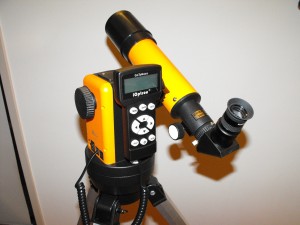
All this brings me to my review of the iOptron Solar 60 computerised telescope system. Having one of these systems give you the option of looking safely at the Sun courtesy of the included solar filter, or using the included webcam to show the eclipsed Sun (or the Moon or any other bright object) to more than one person on a laptop screen. As an aside, the webcam was automatically detected by the Ustream.com website, allowing me to webcast live video to the world without any hassle. The icing on the cake (so to speak) is the fact that the telescope tracking system tracks without hassle, and the whole system (including the tripod) fits in a bag included as part of the package.
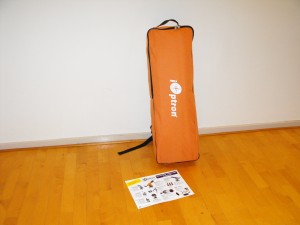
To be honest I am not quite sure where to begin in reviewing the iOptron system. Unlike normal telescopes I have bought, you not only get a small refractor with a computerised mount that tracks what ever you tell it to, but also a solar filter safe for visual observing and a webcam as well.
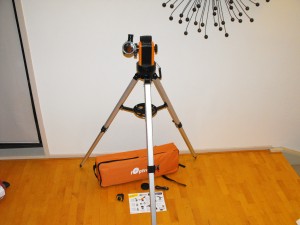
The eye of the system is a 60 mm refractor with a f6.0 focal ratio. With the included 25 mm eyepiece, it gives you a wide field of view with a surprisingly bright image. I say surprising because I am used to using larger telescopes, and I was impressed by the image brightness for bright celestial objects and for daytime use. The wide field of view is important because there is no finder scope included, and therefore you need to use the refractor as the finder scope as well for the initial alignment process.
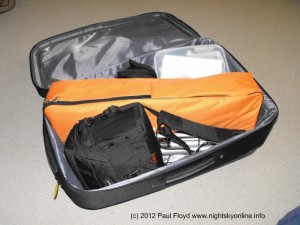
When you unwrap your brand new optical tube assembly (a fancy term for the refractor tube before it has all it’s bits attached) and take the dust tube off, you will discover that the solar filter is already attached to the front of the telescope dew shield. That can easily be unscrewed so that you can use the telescope for looking at objects beside the Sun. Keep in mind that you will need a little container to put the solar filter in while it is not attached to the telescope to avoid damage to the fragile reflective coating on the glass filter. And speaking of which, the underlying substrate is glass. If you drop the filter, it will break.
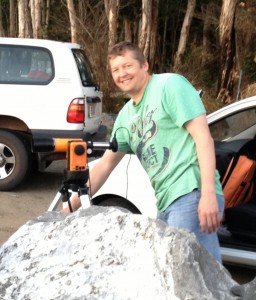
And now to turn to the heart and muscle of the system, the computerised alt-azimuth mount. This comes in three parts: a durable aluminium tripod with a build in eyepiece tray, a bright orange and black (deceptively heavy for its size) base which contains the tracking motors and battery pack and the hand controller with LCD display. This last part is the brain of the system and contains a computer that the Apollo astronauts probably would have killed for. It doesn’t look that impressive but is. Once you have levelled the base using the built in bubble level, keyed in your latitude, longitude and time, and done an initial alignment on a bright object, it will point the telescope at any one of the 5,000 plus objects in it’s database if that object is above your local horizon.
I did work out and solve one limitation with the alignment process. The mount does want you to have the ‘back’ of it pointing South before you turn it on. I didn’t have a compass handy when I first tried out the alignment process and didn’t succeed in aligning the mount properly. On my second go (during the day), I realised that providing the mount was level, I could point the necessary side of the mount approximately to the South and then command the telescope at the Moon or Sun. The in-built computer then calculated where the Moon or Sun were (I tried it twice just to make sure the idea wasn’t randomly working) and moved the telescope to point at the objects. The telescope was of course pointing at the wrong spot because it wasn’t aligned properly. That didn’t matter however because the azimuth of the telescope (what angle it was pointing) was correct. I then slightly undid the nut holding the base on, and rotated the base until the Sun or Moon was in the middle of the eyepiece field. I then did the nut back up and the telescope tracked the object without any hiccup at all.
A couple of warnings if you are going to use this modified method of alignment. Firstly, even if you haven’t told the telescope to point at the Sun, be conscious of which way the telescope is moving. I have had to leap in front of the telescope on more than one occasion as it has been moving when I have realised it was going to momentarily point directly towards the Sun. Upon reflection, my hand in front of the tube would have been as effective and much less dramatic. The second warning has to do with partially undoing the nut that holds the base to the tripod. Undo it too much and the base and telescope will fall off, and that won’t be covered by your warranty! The mount tracked accurately for well over half an hour before it had to be disassembled to to poor weather conditions.
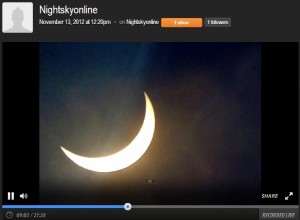
Finally, the webcam. This is an added bonus and ideal if you want to share the view of bright objects (i.e. the Sun, Moon or perhaps a bird in a tree). In terms of field of view, you can view about half of the Moon or Sun at once. Speaking as someone who works with school students, this is a fantastic accessory to include. Children can be unpredictable in how they act around telescopes, and knowing that you can share the experience of a solar eclipse without having to worry about eye safely is fantastic. Being able to share with more than one students is a real bonus from a behaviour management viewpoint too.
So, to sum up, the iOptron Solar 60 computerised telescope system is a small (dare I say it cute) but powerful telescope package and if you are a teacher, a fantastic way to minimise the risks associated with having your classes observe a solar eclipse. You just need to add a few AA batteries plus your position data to be up and running and looking safely at this May’s partial solar eclipse. Add in a laptop computer and you are ready to share a view of the eclipse with a group.
Disclaimer: The importer of the iOptron Solar 60 computerised telescope system is a sponsor of my astronomy website and outreach activities.
1 thought on “Be ready for the next solar eclipse with a iOptron Solar 60 telescope (telescope review)”